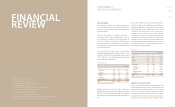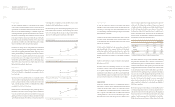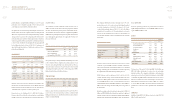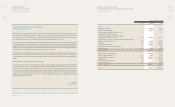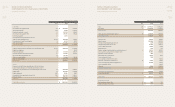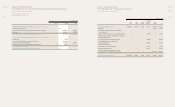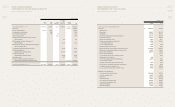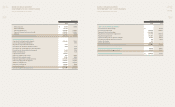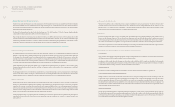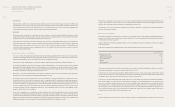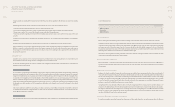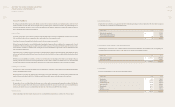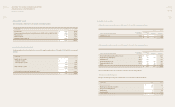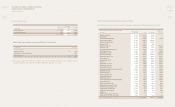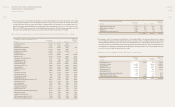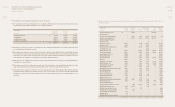Kia 2009 Annual Report Download - page 39
Download and view the complete annual report
Please find page 39 of the 2009 Kia annual report below. You can navigate through the pages in the report by either clicking on the pages listed below, or by using the keyword search tool below to find specific information within the annual report.
NOTES TO NONCONSOLIDATED
FINANCIAL STATEMENTS
December 31, 2009 and 2008
1. ORGANIZATION AND DESCRIPTION OF BUSINESS
Kia Motors Corporation (the “Company”), one of the leading motor vehicle manufacturers in Korea, was established on December 1944 under
the laws of the Republic of Korea to manufacture and sell a range of passenger cars, recreational vehicles and other commercial vehicles in
the domestic and international markets. The Company owns and operates three principal automobile production sites: the Sohari factory, the
Hwasung factory and the Kwangju factory.
The shares of the Company have been listed on the Korea Exchange since 1973. As of December 31, 2009, the Company’s largest shareholder
is Hyundai Motor Company, which holds 34.58 percent of the Company’s stock.
Major foreign subsidiaries for international sales are Kia Motors America, Inc. (KMA) in the United States of America, Kia Canada Inc. (KCI)
in Canada, Kia Motors Deutschland GmbH (KMD) and Kia Motors Europe GmbH (KME) in Germany. Also, the Company established foreign
manufacturing subsidiaries of Kia Motors Slovakia s.r.o (KMS) and Kia Motors Manufacturing Georgia (KMMG) in Slovak Republic and the
United States of America, respectively, to provide the demand of products in Europe and North America, respectively.
2. SUMMARY OF SIGNIFICANT ACCOUNTING POLICIES AND BASIS OF PRESENTING FINANCIAL STATEMENTS
(a) Basis of Presenting Financial Statements
The Company maintains its accounting records in Korean Won and prepares statutory non-consolidated nancial statements in the Korean
language in conformity with accounting principles generally accepted in the Republic of Korea. Certain accounting principles applied by
the Company that conform with nancial accounting standards and accounting principles in the Republic of Korea may not conform with
generally accepted accounting principles in other countries. Accordingly, these financial statements are intended solely for use by those
who are informed about Korean accounting principles and practices. The accompanying non-consolidated nancial statements have been
condensed, restructured and translated into English from the Korean language non-consolidated nancial statements.
Certain information included in the Korean language non-consolidated nancial statements, but not required for a fair presentation of the
Company’s nancial position, results of operations, cash ows or changes in equity is not presented in the accompanying non-consolidated
nancial statements.
The Company prepares the non-consolidated nancial statements in accordance with generally accepted accounting principles in the Republic
of Korea. Except for the adoption of changes to Statements of Korean Accounting Standards (“SKAS”) No.15 Investments in Associates, the
Company applied the same accounting policies that were adopted in the previous year’s non-consolidated nancial statements.
(b) Revenue Recognition
Revenue from the sale of motor vehicles and parts is measured at the fair value of the consideration received or receivable, net of discounts.
Revenue is recognized when the signicant risks and rewards of ownership have been transferred to the buyer, recovery of the consideration
is probable, the associated costs and possible return of goods can be estimated reliably, and there is no continuing management involvement
with the goods; generally upon delivery to end customer. Revenue from other than the sale of vehicles and parts is recognized when the
Company’s revenue-earning activities have been substantially completed, the amount of revenue can be measured reliably, and it is probable
that the economic benets associated with the transaction will ow to the Company.
Long-term installment sales are recognized at the time of shipment of motor vehicles and parts when the signicant risks and rewards of
ownership have been transferred to buyer. Interest income arising from long-term installment sales contracts is recognized using the level
yielding method.
(c) Allowance for Doubtful Accounts
Allowance for doubtful accounts is estimated based on an analysis of individual accounts and past experience of collection. However, when
principals of trade accounts and notes receivable, interest rate or repayment period are changed unfavorably for the creditor by a court
imposition, such as on commencement of reorganization, or by mutual agreement with the Company, and the dierence between nominal
value and present value is material, the dierence is recognized as bad debt expense.
(d) Inventories
Inventories are stated at the lower of cost or net realizable value. Net realizable value is the estimated selling price in the ordinary course of
business, less the estimated selling costs. The cost of inventories is determined on the specic identication method for materials in transit and
on the moving-average method for all other inventories. Amounts of inventory written down to net realizable value due to losses occurring in
the normal course of business are recognized as cost of goods sold and are deducted as an allowance from the carrying value of inventories.
The Company recognizes interest costs and other nancial charges on borrowings associated with inventories that require a long period in the
acquisition, construction or production as an expense in the period in which they are incurred.
(e) Investments in Securities (excluding in associates, subsidiaries and joint ventures)
CLASSIFICATION
Upon acquisition, the Company classies debt and equity securities (excluding investments in subsidiaries, associates and joint ventures) into
the following categories: held-to-maturity, available-for-sale or trading securities.
Investments in debt securities where the Company has the positive intent and ability to hold to maturity are classied as held-to-maturity.
Securities that are acquired principally for the purpose of selling in the short term are classied as trading securities. Investments not classied
as either held-to-maturity or trading securities are classied as available-for-sale securities.
INITIAL RECOGNITION
Investments in securities (excluding investments in subsidiaries, associates and joint ventures) are initially recognized at cost.
SUBSEQUENT MEASUREMENT AND INCOME RECOGNITION
Trading securities are subsequently carried at fair value. Gains and losses arising from changes in the fair value of trading securities are
included in the income statement in the period in which they arise. Available-for-sale securities are subsequently carried at fair value. Gains
and losses arising from changes in the fair value of available-for-sale securities are recognized as accumulated other comprehensive income,
net of tax, directly in equity. Investments in available-for-sale securities that do not have readily determinable fair values are recognized at cost
less impairment, if any. Held-to-maturity investments are carried at amortized cost with interest income and expense recognized in the income
statement using the eective interest method.
FAIR VALUE INFORMATION
The fair value of marketable securities is determined using quoted market prices as of the period end. Non-marketable debt securities are
fair valued by discounting cash ows using the prevailing market rates for debt with a similar credit risk and remaining maturity. Credit risk
is determined using the Company’s credit rating as announced by accredited credit rating agencies in Korea. The fair value of investments in
money market funds is determined by investment management companies.
REDEFINING
MOBILITY
KIA MOTORS
ANNUAL REPORT
2009
REDEFINING
MOBILITY
KIA MOTORS
ANNUAL REPORT
2009


